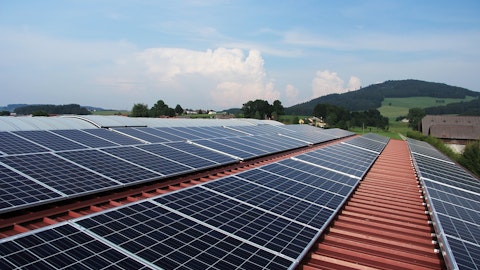Gregg Krug: Well, yes, I think as far as the amount of oil on pipe, it also helps versus being trucked. It’s a lot more efficient. It helps operations as well, streamline that. And so that’s a big benefit to be able to have as much oil on pipe as we do.
Joe Foran: I’d just add that yesterday, we put out our sustainability report. I give credit to the team that drill that together. I think it’s in good shape, make for good nighttime reading and a good reference materials. So, take a look at that, and we’ve worked hard to put more and more on top and to reduce our admissions by 44%.
Shelley Alpern: Sure. This is Shelley Alpern, Director and former ESG Coordinator. And I will say that, in 2022, we had 89% of our operated produced oil on pipe. And to Joe’s point, we’re very, very pleased that from 2019 to 2022, we reduced our greenhouse gas intensity by 44%, so almost cutting it in half over that four-year period.
Operator: Thank you. Our next question comes from Oliver Huang of TPH & Company.
Oliver Huang: Good morning, all, and thanks for taking my questions. My first question, just with respect to the Arrowhead area, there’s a significant portion of your Q4 program in New Mexico coming from there. Assume these wells should be online in pretty short order, but I was just trying to get a better understanding on plans for getting those wells online. Is the thinking there is something similar to kind of the staggered nature we saw out of the margarita wells in that advanced area last quarter?
Tom Elsener: This is — Oliver, thanks for the question. This is Tom Elsener again. As we usually do with the large batches of wells, we typically would bring them online in some sort of staggered fashion. Some of the wells could use artificial lift at varying times. But again, we’ve — it’s something we’ve historically done all throughout the basin, whether that’s Stateline or Rodney or any other kind of large batches of wells. We’re very excited for these wells. This is an area that we’ve been building up to for many years, getting – getting these targets ready, making sure that San Mateo and the team are up there. And so I know, Glenn and the team are excited to get these wells up and running.
Glenn Stetson: Yes. Oliver, this is Glenn. I’d just add that the 17 wells are going to come in at different times, and they’re actually on – on different development units and deliver to different facilities. And so a little bit different than the Advance situation, where you had 21 wells going to one facility but Tom, just what Tom said was is exactly accurate. We’ll bring them on a few at a time. And then they’re all delivering to San Mateo, oil, gas and water, so will help bolster volumes there.
Oliver Huang: Awesome. That’s helpful. And just for a second question, I know in the past, you all have called out activity or even certain pads that might require incremental downtime or shut-ins. So I’m just kind of thinking about this next batch of 20 or so wells in the Advance area in early 2024. Are we going to need to see some of the recently online Margarita wells, either being curtailed or shut in when those come online on the backdrop of, I guess, tighter infrastructure. I’m not sure if the next set of wells is – are enough in proximity within Ranger to where such impacts might be deemed relatively minimal. But really just trying to understand that dynamic as well as we enter next year.
Glenn Stetson: Oliver, this is Glenn, again. The short answer is no. We — the Dagger Lake South development of those — the further — the additional 21 wells are not in proximity to the Margarita wells. And so that the nature of shutting in wells for offset frac protection won’t be a situation on this particular development.
Oliver Huang: Awesome. Thanks for the time.
Operator: Thank you, ladies and gentlemen. This ends the Q&A portion of this morning’s conference call. I’d like to turn the call over to management for any closing remarks.
Joe Foran: Thanks to everyone for their time and attention in this. And I would like to emphasize the fundamentals I said it once already, we started the year at 100,000 barrels. We’re going to end the year not just at 140,000, but 145,000 barrels. That’s a 40%, 45% growth. And meanwhile, we reduced the debt over $200 million from this, while we were keeping those rigs busy and bring those wells online. In addition, Glenn reduced LOE expenses. Through time, we reduced our drilling cost per foot and a time of rising service cost, and we’ve continued to build out the midstream opportunities, improved ESG. So I think it’s been a really good year to this point in a really good quarter and as the stock is off during trading, admit but it’s a buying opportunity.
And I’ve never sold a single share of my stock during the 12 years that we’ve been public and so have most of the other officers. And if you look at it, we’re buyers of stock and not sellers and which — and have great participation from our staff. I think anybody buys at this point is going to be real pleased with the final year’s outcome. And I can understand you would like to have us — have numbers exactly as we think things are going to be, but that’s not a long-term right thing to do nor is it prudent in a time of such volatility. We can tell you that we’re going to be profitable. We’re going to keep that leverage ratio less than 1 unless some spectacular opportunity shows itself, but every moment is to keep the balance sheet strong, production growing, costs coming down, and continued good execution.
We think Midstream enhances our opportunity because that assures us of flow assurance. And as I often said to people on the road, that if you’re going to be a cotton farmer in Dawson County, you need to own part of the cotton gen. The Midstream furnishes that same deal. If you want to get your cotton processed properly, own the part of the cotton chain and we think that Midstream has come in to deliver efficiencies and predictability to what we’re doing. So, we haven’t missed on anything. We just hadn’t had detail for you, and that’s coming, but we can’t do it with full confidence until things settled down a little bit. Taking another look at the fundamentals and come see us. We invite all of you. If you want a more thorough discussion and more time with our senior people come see us.
We’ll set you up and make sure you leave with your — all your questions answered that we’re allowed to under the SEC rules. We play a straight game, but we’re happy to go in further detail on your questions if you can make it here and would like to get to know you all better. But I think you can see that we have strength in areas, our properties are getting better, our people are getting better, and the outlook continues to get better. So, that’s what I’d like to end on with a personal invitation to come see us. I didn’t get — speak today is Ned, our Head of our Geoscience Group, and the outlook for them or working with the acreage that we have, the number of locations and the inventory continues to grow, 10, 15, 20 years out that we see that coming and there work and staying in zone, all contribute to these good results.
So, we wouldn’t have raised dividends if we thought our future was weak and we wouldn’t have gotten the increase in our reserve base loans that we did from the banks unless they saw that we had plenty of reserves and inventory, and we’re headed in the right direction financially. So, with that, I’d like to thank you again for your time and attention and tell you, we look forward to getting with you. The next time, we’ll have more detail, but we’re going to still maintain our flexibility and options because at our size, we think one of our strengths is trying to be nimble enough to take advantage of opportunities as they come up rather than trying to give a five-year outlook. Too much change occurs. And what served us well has been able to adapt to the changing circumstances.
So come see us. This is a great team and great properties, and we’ll go into greater depth. Thanks.
Operator: Ladies and gentlemen, thank you for your participation today. This concludes today’s program.
Follow Matador Resources Co (NYSE:MTDR)
Follow Matador Resources Co (NYSE:MTDR)
Receive real-time insider trading and news alerts


